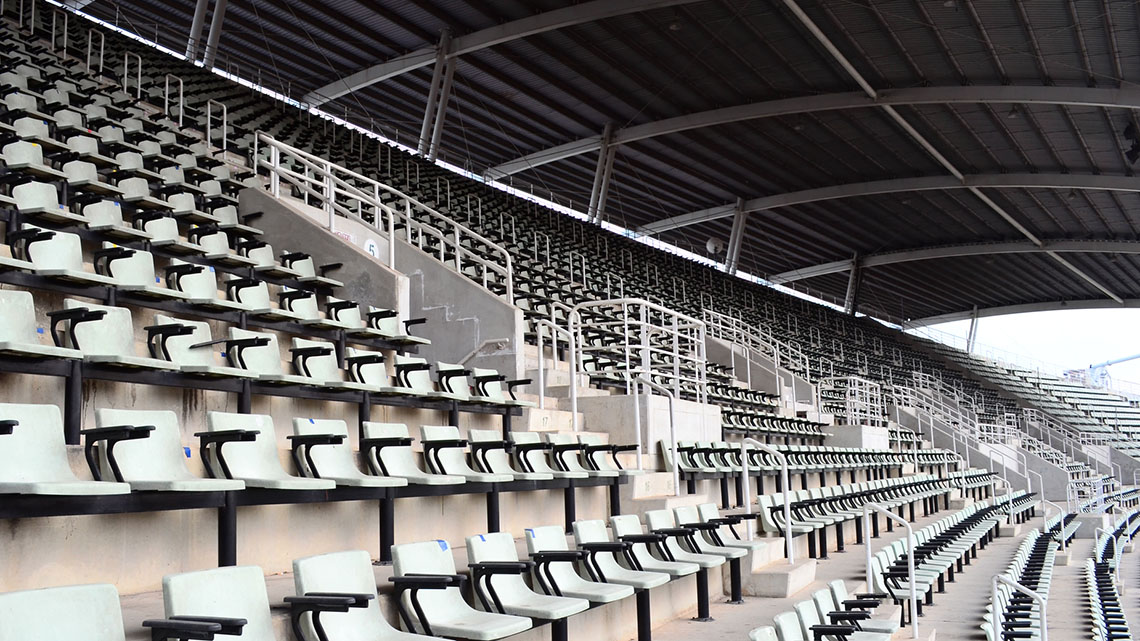Minds On
How many rows?

An architect is designing a stadium that has the overall capacity for 685 people.
The architect has decided they will create sections with rows of seats.
Each row is made up of 15 seats.
Brainstorm
Brainstorm
How many rows would the architect be able to create in total?
Would there be enough seats to accommodate exactly 685 people? Why or why not?
Share your ideas with a partner, if possible.
Action
Exploring division strategies

Let’s revisit our question from the Minds On section.
We know that there is an overall capacity for 685 people and each row has 15 seats.
What strategies could we use to answer the questions:
- How many rows would the architect be able to create in total?
- Would there be enough seats to accommodate exactly 685 people?
Using long division
In order to answer our questions, we will need to divide 685 by 15.
In numbers, this would be:
685 ÷ 15 = ?
One way we can work on solving division problems with larger numbers is by using long division.
Examine the following image to learn more about the different parts of the long division format.

Next, let’s examine the steps to solving a long division question.
Examine the following:
 Description
Description
Long division form for 685 divided by 15. Step 1 says “How many times does 15 go into 685?” and shows a 4 written over the 8 and 60 being subtracted from the 68 above it with a sum of 8. Step 2 shows the 5 being dropped down next to the 8 from the previous step to make 85 and says “How many times does 15 go into 85?”. It then shows a 5 at the end of the quotient and 75 is subtracted from 85 to show a total of 10. Step 3 is adding R10 to the end of the quotient and says “15 cannot go into 10. The answer is 45 with a remainder of 10.”
When we have a leftover amount that cannot be divided any further, we call this a remainder.
In our math equation we express a remainder like this:
685 ÷ 15 = 45 R10
This means that the architect can create 45 equal rows of 15, with 10 people leftover.
While the capacity of the stadium is 685, it can only hold 675 seats if they are in rows of 15.
Your turn: community theatre

Imagine that a local community is building their own theatre for members to enjoy different plays, shows and concerts.
They must determine how many seats will go in each of the following sections:
- upper balcony
- lower floor
- orchestra (the ground floor)
Let’s examine the specifics of each of the sections.
Upper balcony seating

The architect and builders figure out that the upstairs balcony section can hold 215 people.
The architect decides on 8 seats per row.
How many rows can the upper balcony hold?
Will the balcony seat all 215 people?
In a notebook or digitally, use long division, or another method of your choice, to solve the question.
When you’re ready, press ‘Answer’ to access the solution.
215 ÷ 8 = 26 R7
The balcony seating would include 26 rows in total. It would hold 208 people with a leftover of 7 people.
Lower balcony seating

The architect and builders figure out that the lower balcony section can hold 462 people.
This time, the architect decides on 10 seats per row.
How many rows can the ground floor hold?
Will the ground floor seat all 462 people?
In a notebook or digitally, use long division, or another method of your choice, to solve the question.
When you’re ready, press ‘Answer’ to access the solution.
462 ÷ 10 = 46 R2
The ground floor would include 46 rows. It would hold 460 people with a leftover of 2 people.
Orchestra (ground floor) seating

Lastly, the architect and builders figure out that the orchestra section can hold 105 people.
This time, the architect decides on 12 seats per row.
How many rows can the ground floor hold?
Will the ground floor seat all 105 people?
In a notebook or digitally, use long division, or another method of your choice, to solve the question.
When you’re ready, press ‘Answer’ to access the solution.
105 ÷ 12 = 8 R9
The ground floor would include 8 rows. It would hold 96 people in total with a leftover of 9 people.
Consolidation
Create your own problem!

Decide on a scenario or situation and create your own word problem that involves the division of a three-digit number by a two-digit number.
Once you have created your word problem, solve it using a method of your choice such as long division.
Record your work in print, digitally or using an audio recording. If possible, share with a partner.
Reflection
As you read through these descriptions, which sentence best describes how you are feeling about your understanding of this learning activity? Press the button that is beside this sentence.
I feel...
Now, record your ideas using a voice recorder, speech-to-text, or writing tool.
Connect with a TVO Mathify tutor
Think of TVO Mathify as your own personalized math coach, here to support your learning at home. Press ‘TVO Mathify’ to connect with an Ontario Certified Teacher math tutor of your choice. You will need a TVO Mathify login to access this resource.
TVO Mathify (Opens in a new tab)